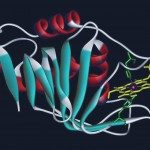Link to Pubmed [PMID] – 10194299
Biochemistry 1999 Mar;38(13):3883-94
We present the solution structure of the nonpalindromic 16 bp DNA 5’d(CTGCTCACTTTCCAGG)3′. 5’d(CCTGGAAAGTGAGCAG)3′ containing a mutated kappaB site for which the mutation of a highly conserved GGG tract of the native kappaB HIV-1 site to CTC abolishes NF-kappaB binding. 1H and 31P NMR spectroscopies have been used together with molecular modeling to determine the fine structure of the duplex. NMR data show evidence for a BI-BII equilibrium of the CpA.TpG steps at the 3′-end of the oligomer. Models for the extreme conformations reached by the mutated duplex (denoted 16M) are proposed in agreement with the NMR data. Since the distribution of BII sites is changed in the mutated duplex compared to that of the native duplex (denoted 16N), large differences are induced in the intrinsic structural properties of both duplexes. In particular, in BII structures, 16M shows a kink located at the 3′-end of the duplex, and in contrast, 16N exhibits an intrinsic global curvature toward the major groove. Whereas 16N can reach a conformation very favorable for the interaction with NF-kappaB, 16M cannot mimic such a conformation and, moreover, its deeper and narrower major groove could hinder the DNA-protein interactions.

